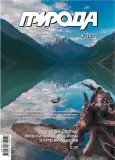编号 9 (2021)
The Second Language of DNA
摘要
DNA is crucial to life. This molecule rests at the heart of a cell nucleus, stands in between most important metabolic pathways, and provides the basis for genetic information flow. However does it really just rest? Is that big and early invention of evolution limited to the inert function of information storage? To address this we tackle several aspects of DNA structure. Each of them may become crucial when the molecule changes its role — when it serves as a blueprint for copying, a site for precise binding of proteins, or is involved in complex and dynamic interactions with them. We focus on promoters which initiate the process of transcription, i.e. the “rewriting” of DNA into RNA. Our setting is the tiny genome of bacteriophage T7 and its petite, very similar yet very distinct promoters.
Priroda. 2021;(9):3-12
 3-12
3-12


Fukalite and Its Cement Friends
摘要
Calcium silicate hydrates (CSH) are widespread in nature and are of particular interest for cement production. Crystalchemical variation of CSH-group representatives results from various Ca/Si ratio and topologically different structural fragments. Ca-polyhedra (octahedra, and 7- or 8-polyhedra) сan be combined in columns and layers of different types and linking Si-radicals vary from isolated monomers, single dimers, trimers, and hexamers to linear and layer groups. We have conducted X-ray analyses of cement hydrosilicate fukalite and compare its structure with CSH-group minerals, composed of Si-tetrahedra linear and layer fragments.
Priroda. 2021;(9):13-23
 13-23
13-23


150th Anniversary of Sevastopol Biological Station — Kovalevsky Institute of Biology of the Southern Seas, RAS
摘要
The article presents, in chronological order, a brief history of formation and development of the first in Russia and one of the first in the world marine biological station, created in Sevastopol in 1871 by remarkable scientists of our country, and reorganized in 1963 into the Institute of Biology of the Southern Seas (IBSS). Generalization of historical material about Sevastopol Biological Station (SBS)—IBSS allows us to highlight the main stages of the development of the institute. The article reflects the role of leaders and leading scientists in the formation of new directions of fundamental and applied research and their major achievements. The history of formation and development of expeditionary works and research fleet of SBS—IBSS is described. The importance of the accumulated scientific potential for further development of marine research and technologies at the Federal Research Center “A.O.Kovalevsky Institute of Biology of the Southern Seas of RAS” and other institutions in the south of Russia is shown.
Priroda. 2021;(9):24-34
 24-34
24-34


Altai Republic: Environmental Problems and Ways to Solve Them
摘要
An overview of the diverse regional and local environmental problems of the Altai Republic and their brief description are given. The natural, natural-anthropogenic, and anthropogenic reasons for the deterioration of the ecological situation in the region are considered. Most of them are now insignificant, but some are growing, and can lead to negative consequences. The ways to solve the most crucial environmental problems are proposed and a conclusion about the generally favorable ecological state of the natural environment on the territory of the Republic is made.
Priroda. 2021;(9):35-46
 35-46
35-46


Once Again About the Area of Kamchatka
摘要
The conducted analysis of the geographical directories and special geographical literature has shown that there is two approximately equally mentioned estimations of the total area of the Peninsula of Kamchatka — 370 and 270 thousand km2. A simple, no time- and effort-consuming method of determination the area by squares or by weighing the cut outs convinces that the measured area of the peninsula is very close to 270 thousand km2 (±2–3 thousand km2). This means that an erroneous estimation of 370 thousand km2 has got inside such authoritative publications as the “Great Soviet Encyclopedia”, various encyclopedic geographical dictionaries, and, consequently, to the new “Great Russian Encyclopedia”.
Priroda. 2021;(9):47-51
 47-51
47-51


Return of the Crystal Palace Park Dinosaurs: Victorian Dinosaurs Today
摘要
The sculptures of extinct animals, created and installed by B.W.Hawkins in the park of the Crystal Palace in London in 1854, were the first such reconstructions and reflected the advances in paleontology of the first half of the 19th century. Today this unique monument of the history of paleontology again attracts the attention of the general public. For specialists, the acquaintance with these reconstructions results in a clearer understanding of the ways and patterns of scientific knowledge in paleontology in a historical perspective.
Priroda. 2021;(9):52-63
 52-63
52-63


How to Raise a Wild Bear. To the 85th anniversary of V.S.Pazhetnov, ecologist, zoologist, and writer
摘要
Poachers, and sometimes people with no respect to the rules of in-a-den hunting, kill a female bear and doom her offspring to death. Practically the best fortune to such cubs is to occur in a circus or a zoo. Is it possible to help orphaned cubs? How to raise a wild bear and to return it to the wild? These questions have long worried zoologists, including V.S.Pazhetnov, who devoted his life to study the behavior and biology of brown bears. This experience allowed him to develop a unique method of raising and rearing bear cubs and to create Orphan Bear Rescue Centre that rehabilitates and reintroduces orphaned brown bear cubs in order to restore their population within the range. Valentin Sergeevich Pazhetnov recently passed away, but his numerous followers, including his wonderful family, are with us.
Priroda. 2021;(9):64-71
 64-71
64-71


SCIENCE NEWS
摘要
A red-light district for a moth (72). Baby bats can babble too (73). Ephemeral structures of baby octopuses (74).
Priroda. 2021;(9):72-74
 72-74
72-74


“A River Begins from a Blue Stream” (review of the book: Ecological Atlas of the Klyazma River Basin: Man in the Environment)
Priroda. 2021;(9):75-78
 75-78
75-78


NEW BOOKS
摘要
С.В.Васильев, Е.В.Веселовская, Р.М.Галеев и др. ИСТОРИЯ РОССИИ В ЛИЦАХ (ПО МАТЕРИАЛАМ АНТРОПОЛОГИЧНСКОЙ РЕКОНСТРУКЦИИ). М.: АМА-Пресс, 2019. 136 с.
Priroda. 2021;(9):79-79
 79-79
79-79










